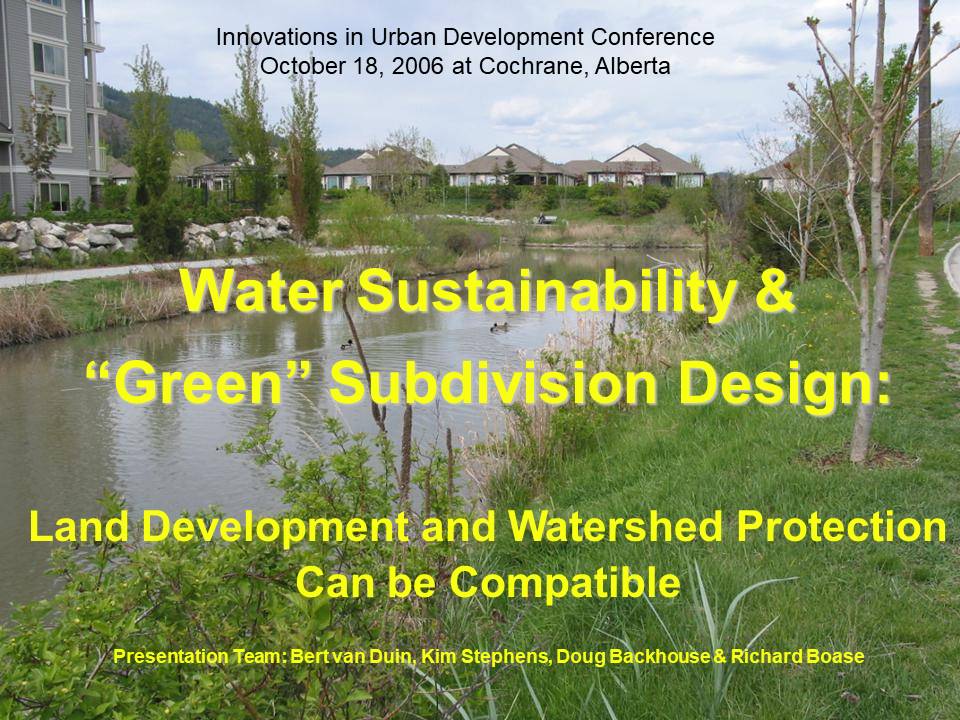FLASHBACK TO 2006: “The urban environments that we can build using LID will be healthier, more sustainable and use less natural resources then the ones we grew up in,” stated Bert van Duin at the Cochrane Innovations in Urban Development Conference
Note to Reader:
The Cochrane Environmental Action Committee (CEAC) in partnership with the Town of Cochrane hosted a Low Impact Development (LID) conference from October 18 to 21, 2006. The program included a pre-conference workshop on the Water Balance Model for Canada. For program details, DOWNLOAD HERE.
Why Low Impact Development?
Bert van Duin, a conference speaker and member of the Steering Committee for the Alberta Low Impact Development Partnership (ALIDP), described LID “as a practical and cost-effective approach to reducing and/or better managing the impacts of urbanization on our landscape in order to leave a better place for our children and grandchildren.”
 “The urban environments that we can build for them using LID will be healthier, more sustainable and use less natural resources then the ones we grew up in. This is an exciting turning point in how we can reduce the impacts of urban development on watersheds”.
“The urban environments that we can build for them using LID will be healthier, more sustainable and use less natural resources then the ones we grew up in. This is an exciting turning point in how we can reduce the impacts of urban development on watersheds”.
van Duin stressed that LID is not a ‘zero’ impact approach because there will always be impacts. “We all need places to live and work,“ said van Duin.
“We all utilize energy, water and natural resources to enjoy the quality of life in the communities in which we live.. LID provides us with better tools to make decisions about how much of the natural landscape we need to disturb, what will happen to the waste products communities create; and, what we can do about these changes to the landscape to prevent many of the negative problems and impacts associated with urban development.”
“The benefits derived from LID are many,” adds van Duin. “Some benefits are on a more global scale — energy conservation and reducing CO2 emissions through the use of solar panels for example. While others benefits are more local. Depending on the LID techniques and the type of development and site constraints, stormwater and overall site development costs can be reduced by 10-25% compared to conventional approaches. Topsoil management is a good example.”
“Prior to development the soil acts like a sponge, receiving precipitation during the winter and spring and holding it for the summer. With traditional development practices the “sponge” is scrapped off and removed from the site, and is replaced with asphalt or concrete, and the remaining soil is compacted as a result of construction activities.”
He went on to explain that when the topsoil is removed, it causes the land to shed a lot more water when it rains. The function of the “sponge” to help with water management is lost resulting in poor drainage leading to flooding and erosion problems in our waterways.
“At the same time residents complain that they can’t grow anything because they do not have enough topsoil when the new landscape is created. The proverbial “one” inch of topsoil and the heavily compacted sub-soils underneath fail to provide adequate growing conditions for our prairie climate” said van Duin.
“Consequently residents end up watering their lawns more because the soil doesn’t have the capability to hold water. But if we keep the topsoil on site and ensure it is about 8-10 inches deep we can maintain and re-create the natural ‘sponge’ with multiple benefits; less runoff, less watering and the creation of a much better environment for our yards and gardens.”
Conference Overview
Tim Giese, a conference organizer, explained that the conference offered interactive workshops and presentations, covering a wide range of topics targeted towards LID application that can be applied not only within the Town of Cochrane, but for all of Western Canada.
“The conference will provide opportunities for planners, developers, town councils, policy makers and other attendees to gain a better understanding of LID concepts and successful real-life initiatives,” said Giese.
He stated that the timing of the conference is perfect to help address the rapid urban growth in the Calgary region. The Bow River is under increasing water quality and quantity pressures from development throughout the basin. LID is emerging as a strategy that can be shared among all municipalities to reduce their development impacts.
Cochrane, in particular, has an opportunity to benefit from the LID conference information and access to experts in determining how it wants to plan and design several new developments on recently annexed land.
LID information will also assist the Town as it undertakes a review of its Municipal Development Plan, which will set the future direction of how Cochrane will address current and future development.
“We’re hoping that the conference will provide a venue to discuss and showcase new urban development strategies, which can be used to help us maintain and continue to build a vibrant and more sustainable community,” said Giese.
He added, “There has already there has been considerable interest in the conference with enthusiastic responses from sponsors and early bird registrations.”
Water Balance Model Workshop
The Alberta Low Impact Development Partnership (ALIDP) and the British Columbia-based Inter-Governmental Partnership (IGP) collaborated to conduct a pre-conference workshop on the Water Balance Model for Canada.
“ We are excited that the team of Kim Stephens, Doug Backhouse and Richard Boase from British Columbia will be doing an online demonstration of this tool. The Cochrane Conference will provide Albertans with an opportunity to see this entertaining team in action. Kim, Doug and Richard provide value because of the way they engage and edinteract with their audiences”, stated Liliana Bozic, ALIDP Co-Chair.
We are excited that the team of Kim Stephens, Doug Backhouse and Richard Boase from British Columbia will be doing an online demonstration of this tool. The Cochrane Conference will provide Albertans with an opportunity to see this entertaining team in action. Kim, Doug and Richard provide value because of the way they engage and edinteract with their audiences”, stated Liliana Bozic, ALIDP Co-Chair.
 According to Kim Stephens, Project Coordinator for the IGP, “We are looking forward to meeting with our Alberta colleagues in Cochrane. Because the workshop will be a half-day event, we are designing it as an online ‘show-and-tell’ demonstration of the Water Balance Model. We hope that this will create interest in taking hands-on training in a computer lab as a workshop outcome.
According to Kim Stephens, Project Coordinator for the IGP, “We are looking forward to meeting with our Alberta colleagues in Cochrane. Because the workshop will be a half-day event, we are designing it as an online ‘show-and-tell’ demonstration of the Water Balance Model. We hope that this will create interest in taking hands-on training in a computer lab as a workshop outcome.
Design with Nature
“At Cochrane, we will be engaging the audience with what we call the ‘Design with Nature Gameshow’. We have found that this is a powerful way to educate practitioners about the benefits of the water balance way-of-thinking,” concluded Kim Stephens.
To Learn More:
Download Water Sustainability & “Green” Subdivision Design: Land Development and Watershed Protection Can be Compatible to view the storyline for Water Balance Model Workshop.
Read Land Development and Watershed Protection Can be Compatible, an article posted on the Rainwater Management community-of-interest.
More About LID
Rapid urbanization of landscapes causes many impacts on the quality and quantity of rainwater and stormwater runoff. Effectively controlling rainwater runoff and addressing the public perceptions associated with the negative impacts of urban development on water resources is increasingly becoming a challenge under various federal and municipal regulations.
The challenge is how to effectively reduce flooding and erosion, protect drinking water supplies, maintain the aquatic and fisheries habitats and provide safe water for recreational activities and ensure the preservation and enhancement of river valleys, streams and wetlands that are impacted by urban development and rainwater runoff.
Low impact development (LID) combines innovative planning and engineering models to control rainwater impacts of urban development with landscape design principles to create environmentally functional home and neighbourhoods that mimic the natural functions of watersheds.
Every time it rains, or snow melts, water drains from undeveloped lands into rivers, streams and lakes. The natural landscape has a certain amount of undisturbed soils as well as trees, plants and grasses that can help absorb the water and filter out sediments and other contaminants.
The impacts of the water from these rainfall events can be managed and controlled through the natural features of the landscape. As soon land is cleared, graded, paved and rainwater runoff is piped somewhere else, impacts on the watershed can become quite severe affecting the quality and quantity of water in rivers, streams and lakes.
The goal of LID is to design homes and neighbourhoods to ensure rainwater runoff, and the negative impacts on the watershed, are controlled through better community planning and site designs. Techniques applied using LID strategies aim to maintain as much of the natural pre-development functions of the landscape as possible.
LID uses a computerized “water balance model” that helps planners and engineers determine what the pre-development water runoff conditions are that maintain a healthy watershed and then compares this information to various scenarios and site designs for proposed developments.
By using this modelling technique, building and landscape practices can be created to further help reduce the impacts of developed areas on watersheds and achieve conditions that are as close to the natural functions of the landscape that protected water resources before development occurred.







